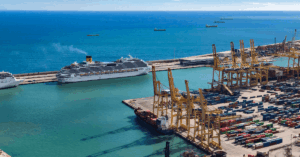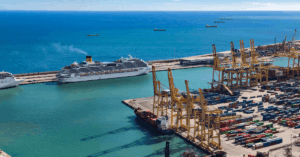
Video: WWII Japanese Destroyer Discovered After 80 Years In Iron Bottom Sound
July 19, 2025
Greek Tankers Reroute Around Africa To Avoid Deadly Red Sea Attacks
July 19, 2025

Barcelona is planning to reduce the number of cruise ship terminals at its port to control the rising number of tourists visiting the city.
The local city council announced that the number of terminals will be brought down from seven to five to make cruise tourism more organised and sustainable.
The decision comes after years of concern over overcrowding caused by cruise passengers, who often arrive in large groups and lead to sudden spikes in congestion.
According to official data, the number of cruise passengers in Barcelona increased by 20% between 2018 and 2024. In just the first five months of 2025, the city recorded a 21% increase in ship calls and a 20% increase in passenger numbers, reaching 1.2 million visitors compared to the same period in 2024.
The mayor of Barcelona stated that he was looking for a new agreement with port authorities to reduce the number of one-day cruise stopovers, which tend to overcrowd tourist landmarks like the Sagrada Familia without contributing much to the local economy.
As part of the new plan, three older terminals will be demolished and merged into a new public terminal with a capacity of 7,000 passengers. The focus will shift to welcoming cruise ships that start or end their journeys in Barcelona rather than just making a short stop. This is expected to encourage longer stays and higher tourist spending.
Alongside this, the city will also build a coastal “mobility corridor” near the port to improve movement for public transport, taxis, bicycles, and pedestrians. The entire redevelopment will begin next year and involve a total public-private investment of €185 million (around $216 million), according to the Port of Barcelona’s president, Jose Alberto Carbonell.
The port authority also said that the new infrastructure will help connect cruise ships to the local electricity grid. This will reduce emissions from ships while they are docked, as per EU regulations mandating onshore power at all major ports by 2030. However, a recent study found that most European ports are not yet on track to meet this deadline.
In 2024, Spanish ports welcomed 12.8 million cruise passengers, and Barcelona was the most visited port in the country, accounting for 3.7 million of those tourists.
The cruise industry in the Catalonia region contributes about €562 million to the local economy every year. On average, cruise tourists spend around €230 per day, which is over €70 more than regular tourists in Barcelona.
Anti-tourism protests have been seen in Barcelona over the years, and the local government has also announced plans to ban short-term rentals by 2029 to help solve the housing crisis.
Reference: Bloomberg
Source: Maritime Shipping News


